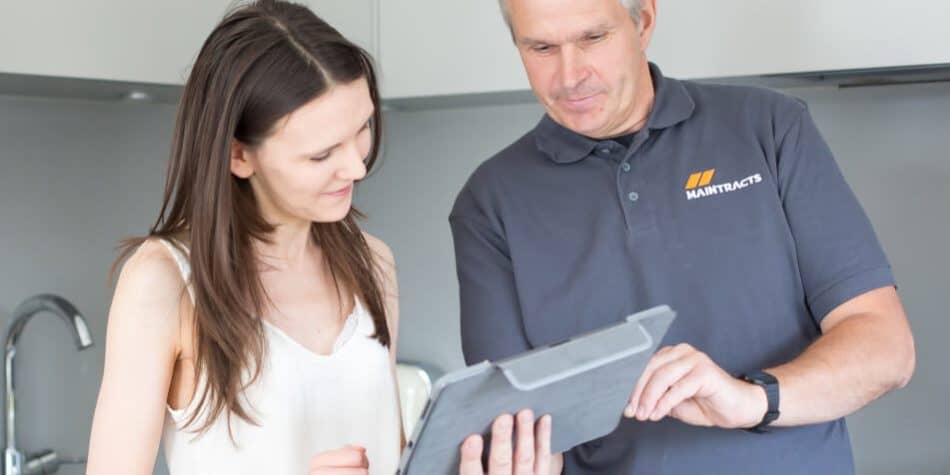Underfloor heating (UFH) is a fantastic way to heat your home. Unlike traditional heating systems, it distributes heat more evenly throughout your rooms and keeps the floor lovely and warm. Homeowners are also able to control the heat of each room/zone independently without the need to have bulky, space sucking radiators on the walls. If you have underfloor heating installed in your property, you may already have some understanding of how it works and may understand that it is designed to run at a lower temperature. It is this element that makes underfloor heating well suited to the energy efficient alternative heat sources that will replace gas boilers in the future. However, you may be wondering if it’s best to have it turned on constantly over the winter, or whether it is best to just turn it on when you need/want it? We explain the most efficient way to run underfloor heating during the autumn and winter months.
The most efficient way to run underfloor heating is to leave it switched on for 24 hours a day, but to increase and decrease the temperatures to suit your requirements. For example, first thing on a winter morning, it would be advisable to set the temperature to a higher temperature (such as 21 degrees) while you get washed, dressed, and get moving. After that, you could drop it down to somewhere between 18 and 16 degrees during the day (even lower if you are going out for the day). When you sit down to relax in the evening, you might like to raise the temperature to 21 degrees again. At bedtime, you could turn it down to 14 degrees, so you are not overheating while you sleep.
The key is to keep the underfloor heating on but operating at a lower temperature during the night and other times throughout the day when it is not needed. Leave it on low even if you are leaving the house to go to work or out for the day.
Here is what Malcolm Osmore, founder and managing director at Maintracts Services in London had to say:

Why is it better to have underfloor
heating on all the time in winter?
Essentially, with wet underfloor heating, your floor becomes a radiator. Unlike a radiator within a traditional central heating system, it is hidden under a solid floor (if on ground level). Therefore, it will need to warm up the substructure and penetrate through many layers before it even begins to warm up the room; it will have to heat through foam insulation, floor screed, tiles/stone or wood flooring/carpet underlay with a layer of carpet on top before you feel the ambient heat in the room. If you experience issues with your heating system, such as inadequate heat distribution, you might consider consulting a professional for radiator repair. The underfloor heating could be anything from 50 to 100 millimetres below the finished floor.
The point here is that it will take time and effort for an underfloor heating system to heat up and reach the desired ambient temperature compared with a traditional radiator that only needs to penetrate through a thin metal casing. The heating up process of wet underfloor heating could take anything up to two hours if turning the system on from cold. However, if the floor is already warm, it will maintain the heat and the heat will come through much quicker. The key is not to let the system go cold.
A good analogy here would be to compare the heating up process of UFH to that of heating up a pan of water during cooking – the time and energy is concentrated on heating the water up to boiling point, after which you can turn the heat and the effort from boiling, down to a simmer relatively quickly.
Overall, keeping the UFH on but altering the temperature up and down is the economical way to run the system, because most of the energy is used to turn the system on and heat up to the required temperature. If you have ever watched World’s Strongest Man on television, you will know that one of the challenges is for the strong man to pull a lorry. Most of the strong man’s energy is used to get the lorry moving. Once it’s moving, he can normally maintain momentum with ease – the same applies to underfloor heating!
Why does a radiator heat up quicker than underfloor heating?
With a radiator, the hot water heated up by the boiler runs into the radiator and only must penetrate a very thin layer of steel before you can feel the heat. Underfloor heating must penetrate several layers of challenging materials before the heat can be felt in the room as described above. Therefore, a radiator heats up a room much quicker that underfloor heating.
However, traditional radiators only heat the chilly air in their immediate vicinity and rely on warm air rising upwards to the ceiling to heat the rest of the room. The result is a mass of warm air at ceiling level and cooler air at the bottom, meaning the floor is the coldest place in the room.
Underfloor heating, on the other hand, produces and emits radiant heat from floor level that is evenly distributed across the entire surface and radiates upwards. The result is the entire floor working as one big radiant heater that heats the people in the room rather than objects! No cold spots, overheating, or energy wastage.
Does it matter where I place my underfloor heating thermostat?
Avoid placing your thermostat in a sunny position, above or opposite a radiator, above the television, or anywhere else that produces heat – including the kitchen if you’re cooking! Remember, a thermostat reads the temperature of its immediate surrounding area, which is not always an accurate reflection of the temperature of the rest of the house/room. Placing the thermostat in the living room or the hallway works well.
If you want a modern alternative to traditional radiators, water- or electric-based underfloor heating could be for you. Check out the benefits of this increasingly popular, energy-efficient heating option. Feel free to Contact our team for more information or to get started.

